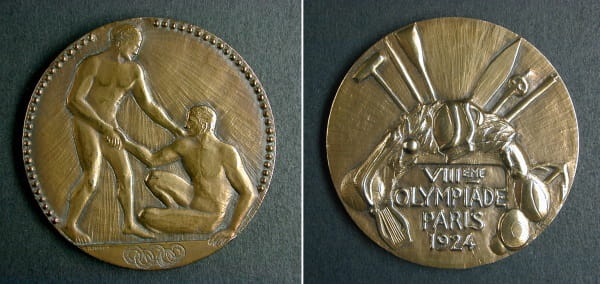Henry Stallard – the Olympian ophthalmologist
02 Aug 2024
Sarah Gillam
This year marks one hundred years since the 1924 Olympics. At those Games, two outstanding medical students and a young doctor won medals – Hyla (“Henry”) Stallard (1901-1973), Arthur Porritt (1900-1994) and Theodore Howard Somervell (1890-1975). All three went on to become distinguished and pioneering surgeons in their own specialties.
Henry Stallard, considered one of the best middle-distance runners England has ever produced, began running at his public school, Sherborne, and continued at Gonville and Caius College, Cambridge, where he was a friend and contemporary of Harold Abrahams, another great Olympic runner.
Above: Stallard race ready. Agence de presse Meurisse.“Stade Pershing, match athlétisme France-Angleterre : Stallard, gagnant du 1500 m : [photographie de presse] / Agence Meurisse”. Paris: Agence Meurisse; 1923. Public Domain. Available from: Wikimedia Commons.
In 1920, Stallard was one of four athletes chosen to run for Oxford and Cambridge against an American universities team in a two-mile relay race in Pennsylvania. The English team won and set a new world record. The New York Globe, recognising Stallard’s talent, looked ahead to the upcoming Olympics: “American milers must watch Stallard at Antwerp. Cambridge runner…is coming fast.” But the young runner had broken a toe in the US race and was ruled out of the 1920 Olympics.
Stallard graduated with a BA in 1922 and won a Shuter scholarship to Barts for his clinical studies. While his medical career progressed, he continued his athletic training, running in the empty streets around Barts at night. His determination paid off: in the trials for the 1924 Olympics Stallard beat his rival Douglas Lowe in the half mile and was selected to run for Great Britain in the 800 and 1,500 metres.
In July he sailed with the British team to France to attend the Eighth Olympiad. At Paris, in the Colombes stadium, a gruelling programme of track events meant Stallard was scheduled to run in five races over five consecutive days. And, disastrously, early on, he sustained a serious injury to his right foot.
On Tuesday 8 July, in the final of the 800 metres, Stallard selflessly set the pace, leading for much of the race, sacrificing his own chances of success. His teammate Lowe won gold and Stallard came in fourth. On Wednesday 9th Stallard won his semi-final of the 1,500 metres and qualified for the final, scheduled for the next day. He knew he would face a formidable line-up, including the world record holder, the exceptional Finnish runner Paavo Nurmi.
The night before the race the British team doctor tightly strapped Stallard’s foot and warned him against running. Philip Noel-Baker, the team captain, also tried to persuade him not to run, but Stallard was determined, reportedly saying: “I am going to run tomorrow if I never run again”.
In terrible pain, Stallard ran the race. He came in third, just behind the Swiss athlete Wilhelm “Willy” Schärer, and two seconds behind the winner Nurmi, who set a new Olympic record. After crossing the finishing line, Stallard collapsed, became unconscious and was stretchered off the field. The Times special correspondent gave a track-side account:
Stallard…has run magnificently throughout the meeting, in spite of the fact that he has a bad and bandaged foot which hurts him every step he takes. In to-day’s [event]…he ran himself out, so that he collapsed, and after a quarter of an hour spent in trying to bring him round, he had to be carried from the arena on a stretcher…. the whole stadium cheered and clapped in recognition of his pluck.
Above: Stallard's bronze medal from the 1924 Olympiad. Image reproduced with the kind permission of The Royal College of Ophthalmologists.
He had run three races in three days and won a bronze medal, all, it turned out, on a stress fracture to a metatarsal bone in his right foot. He was hailed as a hero by the British press and, when he returned to London, was carried shoulder-high by his athlete colleagues as the team celebrated.
Stallard continued to run over the next few years, including representing Great Britain against America, Germany and France. At the Amateur Athletics Association (AAA) he is still the only runner to have won the mile, half mile and quarter mile over three consecutive years (1923 to 1925), missing the chance of a fourth title when he withdrew from the 1926 AAA championships after giving blood to save a man’s life.
Above: Formal portrait of Henry Stallard. Image reproduced with the kind permission of Moorfields Association.
In 1928 Stallard was forced to retire from athletics after recurrent stress fractures in both feet, the same year he gained his FRCS. He went on to have an exceptional career as an ophthalmologist and was known world-wide for his work researching and treating eye cancers in children. A consultant at Moorfields and Barts, he wrote a key textbook Stallard’s eye surgery and, later in his career, became president of the ophthalmic section of the Royal Society of Medicine and of the Ophthalmological Society of the United Kingdom, a post he held up until his death from cancer in 1973.
There are more stories about Olympian surgeons on our Library Blog page. Read about Arthur Porritt, who won a bronze medal in the 100m sprint in the 1924 Olympic Games in Paris, and Theodore Howard Somervell, awarded one of the first Olympic gold medals for alpinism (or mountaineering) in 1924.
Sarah Gillam, Lives of the Fellows Biographies Editor
Further information:
The Olympian Ophthalmologist is a short film created by the Royal College of Ophthalmologists that shares Stallard’s hitherto unseen memorabilia (accessed 28 May 2024).
Sen M, Honavar S G. “Hyla Bristow Stallard: Citius, Altius, Fortius”. Indian Journal of Ophthalmology. 2021 [cited 2024 May 28]; 69(9): 2252–2255. Available from: doi: 10.4103/ijo.IJO_2054_21, or https://www.ncbi.nlm.nih.gov/pmc/articles/PMC8544054/.
The Stallard archive including his medals is held in the Joint Library of Ophthalmology, Moorfields Eye Hospital & UCL Institute of Ophthalmology.



